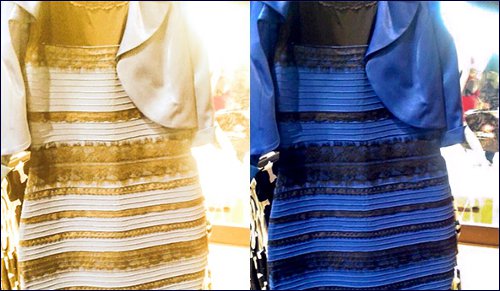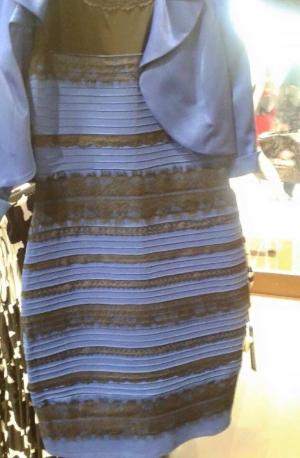 Iran’s Attack on Israel
Iran’s Attack on Israel


4 min read
Appearances can be deceiving.
 What color is this dress?
What color is this dress?
What do you see when you look at this dress: blue and black – or white and gold?
Congratulations, you’ve just joined the biggest internet sensation in years – possibly ever. The garment in question has been dubbed the dress that burned the internet, and it’s easy to see why: in less than a week, tens of millions of people across the globe have taken a peek – and disagreed about what color it is.
It all began when the mother of a bride-to-be in Scotland e-mailed her daughter a picture of the dress she was planning to wear to her wedding: her daughter saw a white and gold gown, while her fiancé thought it was black and blue. They posted a picture of the dress on facebook, where some viewers saw a blue and black frock; others were sure it was cream and gold. Interest intensified at their wedding on the small Scottish island of Colonsay on February 21, 2015: guests couldn’t agree what color photos of the dress were. (The dress is consistently one color in person: read to the end to find out what it is!)
A member of the wedding band was so intrigued she posted the picture on Tumblr, and it became a viral sensation. By Friday afternoon, less than a week after the wedding, one social media site recorded 28 million views of the dress, and pictures of it were blanketing the internet. Kim Kardashian West spoke for millions when she tweeted “I see white & gold. Kayne sees black and blue, who is color blind?”
It’s not only the color of the dress that has people divided; scientists have also put forward differing theories about what’s going on, ranging from the difficulties our eyes have processing some colors, to our brains’ need for clues about color from ambient light. Getting into the craze was Lee Hsien Loon, the Prime Minister of Singapore, who explained one theory on his facebook page: “We think of the colour of things as being something fixed, a property of the thing. But in fact what colour we see depends on the context in which we see the thing….”
The wonder of the dress comes at a perfect time in the Jewish calendar – the season of Purim, which is celebrated by making seemingly-ordinary things become slightly off-kilter. Of all the Jewish holidays, Purim can be the most raucous; we enjoying dressing up in costumes, going to parties, and infusing the day with humor through funny jokes and plays. The special redemption the Jews witnessed on Purim is “v’nahafoch hu” – everything was turned about, and it reminds us that God can bring about stunning reversals of fortune in an instant.
Purim describes a world that seems utterly mixed-up and confused: Esther the Queen of Persia is really a Jew; Mordechai, who saved the king’s life, is really Esther’s cousin, but nobody knows; Haman, the trusted advisor to the king, thinks he will be honored but in reality it’s his arch-nemesis Mordechai, who is rewarded instead. Haman is hanged on the gallows he had built for Mordechai. The Jews, a weak people scattered throughout the mighty Persian Empire, are marked for genocidal destruction, but it is they who triumph in the end.
The biggest puzzle of all in Purim is the fact that the Almighty’s identity, too, is hidden in Purim’s narrative. The Book of Esther is the only one of the Torah’s 24 books that fails to mention God by name. The Divine is everywhere in Purim’s story, but His hand is hidden, disguised as coincidence, camouflaged as chance and lucky turns of fate. It’s only when we step back and look at Purim in its entirety – when we view the sweep of its many coincidences, look afresh the ultimate meanings of its many seemingly unimportant details – the whole story of Purim emerges.
Purim reminds us that we don’t always have all of the details we need to make a final judgment; we can’t always see the big picture. It’s a day for asking ourselves if what we really perceive is the whole story, and for reminding ourselves that there’s room for doubt.
The dress that burned the internet is a great Purim lesson, coming just in time for this festive day. Appearances are deceptive – whether we’re reading about Mordechai and Esther thousands of years ago in ancient Persia – or viewing one mystifying Scottish dress – black and blue in person – but of variable color, on our computer screens today.
